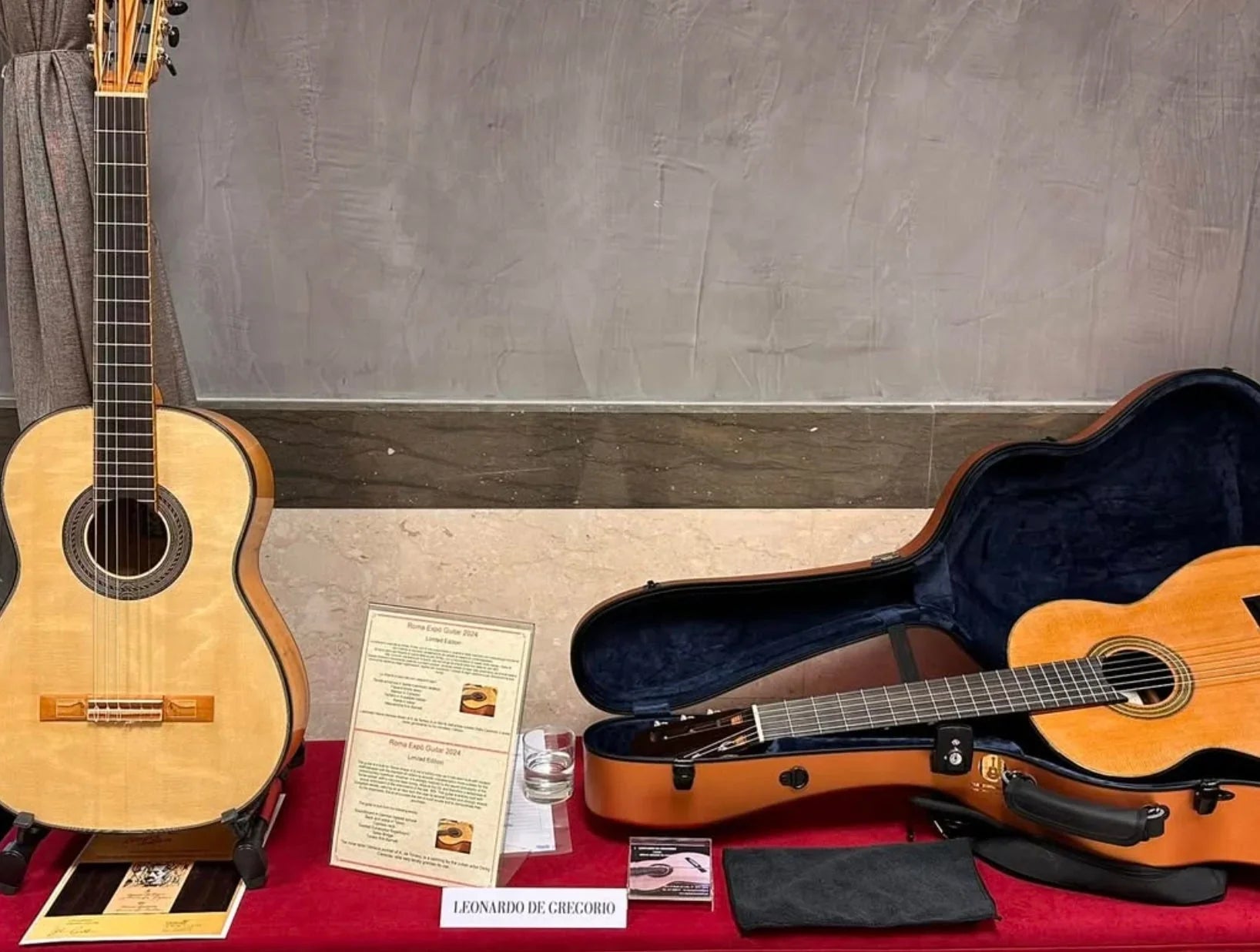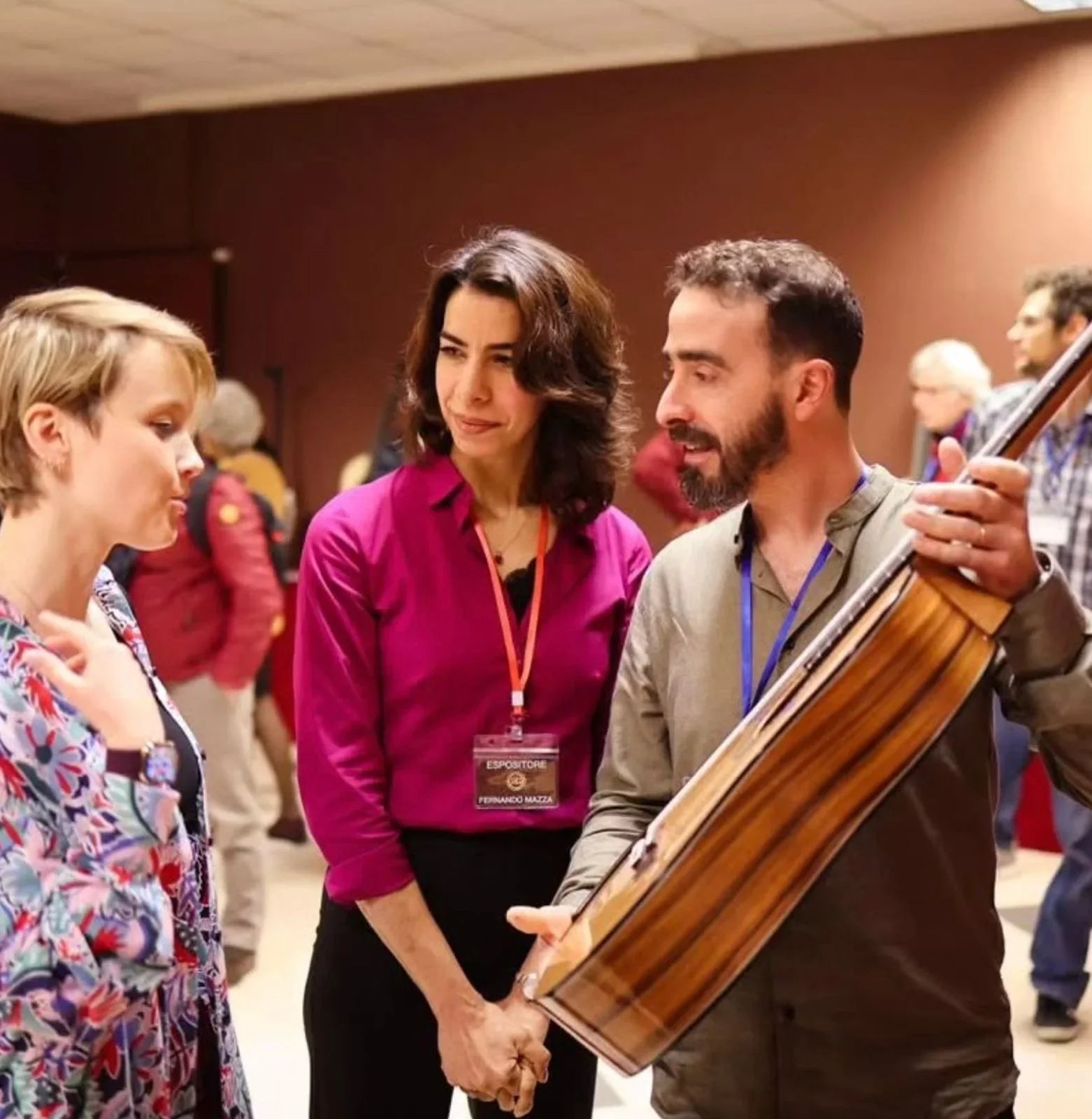At Alba GB, we’re honored to wrap up our conversation series with master Italian luthier Leonardo De Gregorio. In this final part, we discuss how Leonardo’s work has matured over the years, explore his early instruments, and highlight his recent collaboration with fellow luthier Romano for REG 2025. We’ll also learn about some remarkable artists currently performing with Leonardo’s guitars.
The Early Years: Leonardo’s First Guitars
Alba GB:
Leonardo, your guitars today are known for refined detail and balanced sound. How did your earliest instruments differ from your current guitars in terms of construction and materials?
Leonardo De Gregorio:
Surprisingly, my early experiments turned out really well and matured outstandingly. This was largely thanks to my teacher and mentors, who guided me closely during those first crucial years. Initially, I built with more traditional methods, thicker tops, more substantial bracing, and primarily spruce for soundboards. Over time, my construction gradually evolved towards lighter tops and more responsive designs. But even those first guitars, built with careful mentorship, continue to sound excellent today.
Read Also: Master Luthiery: Talking with Leonardo De Gregorio about Classical Guitars (Part 1)
Evolution of Material Selection
Alba GB:
Over the years, how has your approach to selecting woods changed?
Leonardo De Gregorio:
Initially, I focused heavily on visual appeal. With experience, I’ve learned to trust acoustic properties first. Now I select woods primarily based on their responsiveness, resonance, and structural stability. My choice of wood today always serves acoustic goals. This shift in priorities has profoundly shaped the sound quality and longevity of my guitars.
Read Also: Leonardo De Gregorio: Italian Luthiery Tradition & Double Top Classical Guitars (Part 2)
Influential Turning Points
Alba GB:
Were there specific moments or influences that significantly changed your approach?
Leonardo De Gregorio:
Yes, attending international guitar expos, meeting leading musicians, and discussions with other respected luthiers changed my perspective. One major turning point was discovering the potential of double-top construction about a decade ago. Another was experimenting more confidently with cedar, learning to handle it properly to achieve the sound qualities I sought. These discoveries dramatically expanded my approach to classical guitar making.
Read Also: Double Top vs. Traditional Top Classical Guitars: Construction and Tone
Collaboration with Romano for REG 2025
Alba GB:
Recently, you collaborated with your colleague Romano on a guitar project for REG 2025. Can you tell us about that experience and the guitar you created together?
Leonardo De Gregorio:
Collaborating with Romano was a fantastic experience. Romano brings a deep knowledge of traditional Roman guitar making, especially regarding tonal projection and clarity. For REG 2025, we combined our methods, balancing my lightweight, flexible approach with Romano’s meticulous attention to tonal clarity and projection. The guitar we made uses carefully selected Alpine spruce for the top and unique Brazilian rosewood for the back and sides. The bracing is a hybrid system, integrating elements of both our techniques. The result is a guitar that beautifully blends our individual strengths—rich, clear, and versatile.
Read Also: Classical Guitar Armrest: Comfort, Protection, and Superior Sound
Building Together: The Value of Luthier Collaboration
Alba GB:
Do you think collaborations like these influence your future work?
Leonardo De Gregorio:
Absolutely. Working with Romano was both inspiring and educational. It challenged my thinking and opened new possibilities. Collaborations force you to reconsider your habits, methods, and assumptions. This experience gave me fresh insights, and I plan to integrate some elements of Romano’s approach into my future instruments.
Read Also: Metal Guitar Beads: Better Tone, Sustain, and Playability
Notable Artists Who Play Leonardo’s Guitars
Alba GB:
Your guitars are now played by renowned artists worldwide. Could you share some of these musicians with us?
Leonardo De Gregorio:
I’m grateful to have my instruments played by exceptional guitarists. Among them are Massimo Delle Cese e Arturo Tallini, whose playing perfectly suits my instruments. Gianmarco Ciampa has also been performing extensively with one of my double-top guitars, highlighting its dynamic capabilities. Each of these artists offers invaluable feedback, helping me continuously improve.
Read Also: How Plastic Guitar Beads Improve Classical Guitar’s Sound
The Artist-Luthier Relationship
Alba GB:
How does direct feedback from guitarists influence your work?
Leonardo De Gregorio:
Feedback is essential. It informs my decisions about everything—bracing patterns, neck shapes, wood choices, even small ergonomic adjustments. Hearing directly from musicians allows me to make subtle refinements that matter profoundly to professional performers. It’s an ongoing dialogue that benefits both the artist and my future guitars.
Read Also: The Evolution of Classical Guitar Supports: Steadiness, Innovation
Advice to Aspiring Luthiers
Alba GB:
Based on your journey, what advice would you give to young luthiers starting their careers?
Leonardo De Gregorio:
I’d advise patience and openness. It’s vital to start with foundational techniques—learn traditional methods thoroughly before experimenting too boldly. Always stay open to learning, attend guitar exhibitions, speak directly with players, and never ignore their feedback. Build relationships, be curious, and let your work evolve naturally.
Read Also: Plastic Guitar Beads vs Metal Guitar Beads
Reflections on a Lifelong Craft
Alba GB:
As we conclude our series, how do you see your work evolving in the coming years?
Leonardo De Gregorio:
I’ll continue refining my double-top construction, pushing its boundaries without losing the authenticity of the Italian voice. I’ll explore further collaborations like the one with Romano, as I believe they enrich my perspective. The essence of guitar making is continuous learning, never becoming static. As long as I keep discovering, I will keep growing as a luthier.
Read Also: Carbon Case for Classical Guitar: Style, Protection and Comfort for Musicians on the Go
Alba GB:
Leonardo, thank you so much for sharing your journey, expertise, and passion across these three conversations.
Leonardo De Gregorio:
Thank you sincerely. It’s always a privilege to discuss these topics in depth with you. I look forward to our next conversations.
Alba GB:
We are definitely going to knock on your door again when we receive our first instrument from you soon. We’ll have another conversation about the guitar and more. And thank you to our readers. Keep following Alba GB for future interviews and insights, as well as professional classical guitars for sale, crafted by exceptional luthiers like Leonardo De Gregorio.
Find Professional Classical Guitars at Alba GB
At Alba GB, we proudly offer professional classical guitars, including handcrafted double-top models by Leonardo De Gregorio. Explore our carefully curated selection or contact us directly for details on available instruments. Shop classical guitars now and find your next high-end classical guitar.





Leave a comment
This site is protected by hCaptcha and the hCaptcha Privacy Policy and Terms of Service apply.